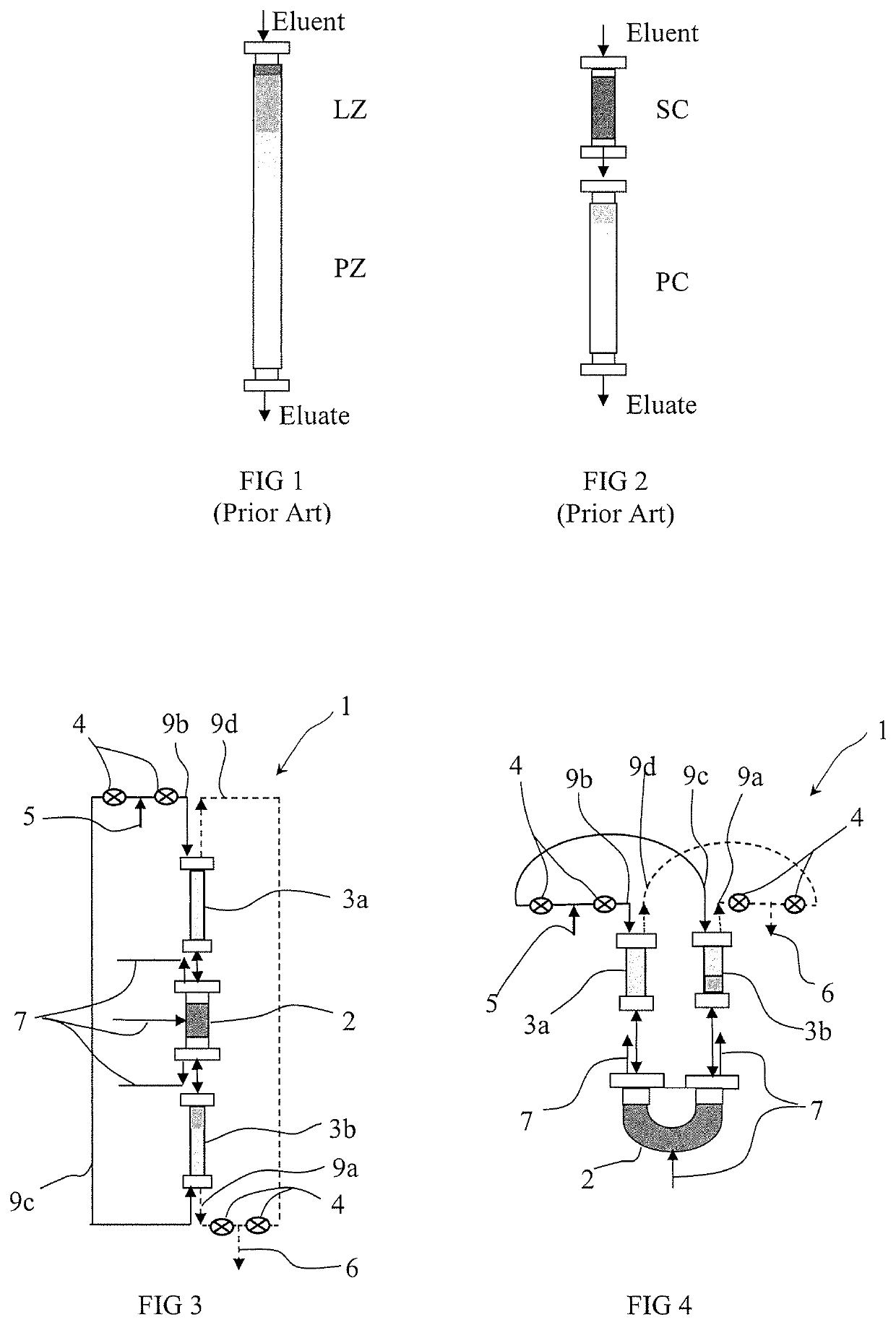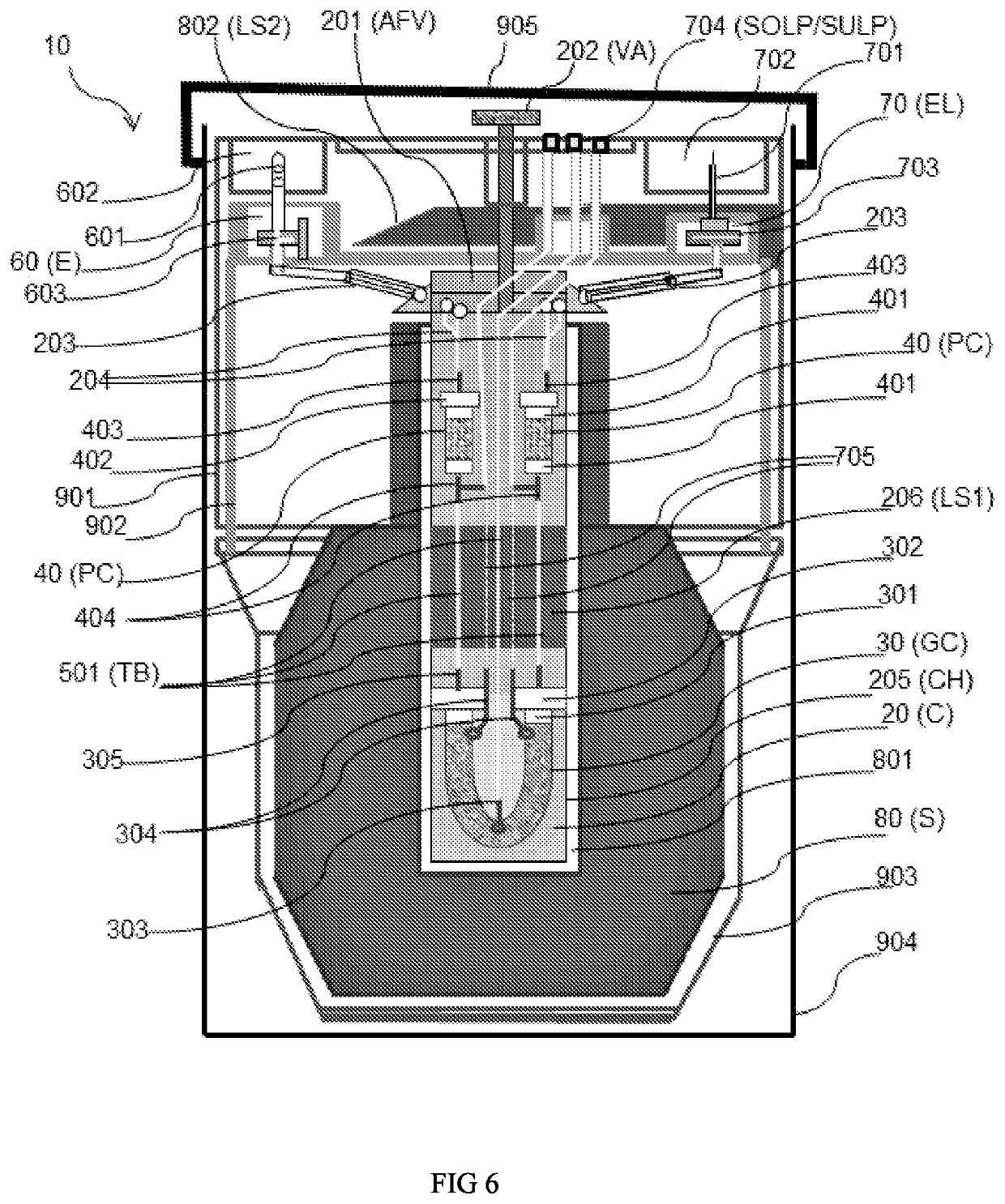Alternating flow column chromatography apparatus and method of use
a chromatography apparatus and alternating flow technology, applied in the field of chromatography columns, can solve the problems of unacceptably low radioactive concentration of sup>99m/sup>tc-eluate solution for use in most radiopharmaceutical diagnostic procedures, poor adsorption-desorption kinetics, etc., to achieve maximum sharpness, increase the purification effect of the purification column, and maximize the loading capacity of the separation column
- Summary
- Abstract
- Description
- Claims
- Application Information
AI Technical Summary
Benefits of technology
Problems solved by technology
Method used
Image
Examples
first embodiment
[0081]an alternating flow column chromatography (AFCC) apparatus for the chromatographic separation and chromatographic purification of the ionic radionuclide components and chemical components of size <2.5 nm (<25 Å) soluble in an aqueous solution is depicted schematically in FIG. 3.
[0082]The composition to be separated is a mixture of ionic desired (target or product) components, ionic product-generating components and ionic contaminant components (including the breakthrough of ionic product-generating components leachable from the separation and purification columns into eluate flow). The components (species) of the composition to be separated are ionic and / or non-ionic molecules of size <2.5 nm soluble in an aqueous solution. The product component may be generated from a product-generating component as a result of chemical, biochemical and nuclear (radiochemical) decomposition processes. The decomposition process may be an in-situ process occurring inside of the separation colum...
third embodiment
[0087]In order to better describe the invention a more detailed illustration of an alternating flow column chromatography (AFCC) apparatus is shown in FIG. 5. Suitably the AFCC apparatus is setup in the format of an integrated device, preferably in a format of benchtop device operated by a limited vacuum driving force for eluent / eluate liquid flow communication without using differential pressure controllers.
[0088]As with the first and second embodiments, the apparatus 1 consists of a separation column 2, a pair of purification columns 3a, 3b, and an alternating flow valve 4. In the third embodiment, the separation column 2 has a ‘U’ shape, although it could also be configured with an ‘I’ shape. The alternating flow valve 4 is operated to reverse the direction of the eluent flow from feed eluent port 5 to eluate collection port 6 through the columns 2, 3a, 3b. A mixture of species to be separated may be loaded through a central separation column loading port 7a or through loading po...
example 1
od Based 68Ga-Generator Using High Specific Activity 68Ge-Source (Operation Per FIG. 13a)
[0193]This example of the present invention relates to the 68Ga generators produced based on the nano-crystalline sorbent ZT-11 (Adsorption capacity: 1.3 mg Ge / g sorbent) and the multifunctional sorbent ISOSORB-MOX-HP (Adsorption capacity: 3.0 mg Ge / g), which are specified in the patent applications WO 2011 / 106847 A1 and WO 2015 / 039170A1, respectively. 68Ge-source of high specific activity 1.6 mCi 68Ge / μg Ge was used for loading the generator column.
[0194]These sorbents are in solid particulate form, so that the generator columns contain a packed bed of the particulate sorbent. Both sorbents have a much higher affinity for 68Ge than for 68Ga so that 68Ga is preferentially eluted from the sorbent while the majority, preferably substantially all, of the 68Ge is retained on the sorbent. Typically both sorbents ZT-11 and ISOSORB-MOX-HP are such that the breakthrough percentage of 68Ge is less than 1...
PUM
| Property | Measurement | Unit |
|---|---|---|
| particle size | aaaaa | aaaaa |
| particle size | aaaaa | aaaaa |
| energy | aaaaa | aaaaa |
Abstract
Description
Claims
Application Information
 Login to View More
Login to View More - R&D
- Intellectual Property
- Life Sciences
- Materials
- Tech Scout
- Unparalleled Data Quality
- Higher Quality Content
- 60% Fewer Hallucinations
Browse by: Latest US Patents, China's latest patents, Technical Efficacy Thesaurus, Application Domain, Technology Topic, Popular Technical Reports.
© 2025 PatSnap. All rights reserved.Legal|Privacy policy|Modern Slavery Act Transparency Statement|Sitemap|About US| Contact US: help@patsnap.com



